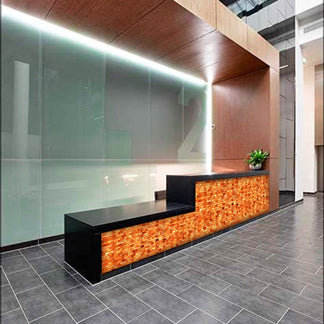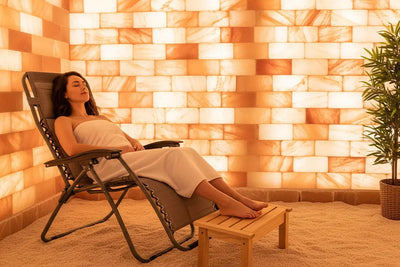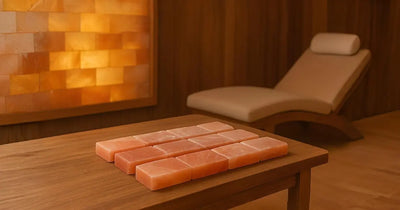
The aesthetic qualities of Himalayan salt bricks in outdoor sculpture
When we think of outdoor sculptures, materials such as bronze, stone, and steel often come to mind. However, there is another material that has recently gained popularity among artists and designers - Himalayan salt bricks. These Salt blocks are used for a variety of purposes, including in cooking and as salt licks for livestock. But their unique aesthetic qualities have also made them an intriguing choice for outdoor sculpture. In this article, we will examine the use of these bricks in outdoor sculpture and explore their aesthetic qualities.
Exploring the Himalayan Salt Bricks
These are made from compressed salt, usually obtained from salt mines or evaporated seawater. The salt is first mined or extracted, then purified, ground, and compressed into bricks using hydraulic presses. The resulting bricks are smooth and dense, with a characteristic translucent quality that allows light to pass through them.
The aesthetic qualities of salt blocks
These bricks have several aesthetic qualities that make them a unique and intriguing material for outdoor sculpture. Here are some of the key aesthetic qualities:
Translucency
The translucency of Himalayan salt bricks is one of their most unique and alluring qualities. When light passes through the bricks, it creates a luminous effect that is both enchanting and mesmerizing. This effect is particularly striking when the bricks are illuminated from within, either by natural light or artificial lighting. The interplay between the light and the bricks creates a magical and ethereal ambiance that is sure to capture the attention of anyone who sees it. The translucency of the bricks is a quality that makes them an ideal material for creating captivating and visually stunning outdoor sculptures.
Texture
The texture of Himalayan salt bricks is one of their most distinctive features. The compression process used to create the bricks leaves small indentations and imperfections on the surface, resulting in a texture that is both smooth and slightly rough. This texture gives the bricks a natural, organic feel that evokes the rugged and raw character of the salt mines where they are often sourced. The texture of the bricks is not only visually appealing but also adds a tactile element to the sculpture, making it an interactive and engaging piece of art.
Color
Himalayan salt bricks are known for their natural variation in color, which ranges from pure white to pale pink and beige. These colors are created by the impurities that are present in the salt, such as iron oxide and calcium carbonate. The combination of these impurities with the salt gives each brick a unique character that is both subtle and rich. This natural variation in color can be used by artists and designers to create stunning outdoor sculptures that are both visually striking and organically beautiful.
Durability
These bricks are renowned for their durability and resistance to weathering, making them a reliable material for outdoor sculptures. They are resistant to water, frost, and heat, which means they can withstand the elements without deteriorating quickly.
Moreover, the bricks' natural erosion process over time creates a unique patina that adds to their aesthetic appeal. This patina not only enhances their beauty but also adds a layer of character to the sculpture, making it an even more captivating piece of art.
The use of Himalayan salt bricks in outdoor sculpture
You can use these bricks in a range of outdoor sculpture projects, showcasing their versatility and aesthetic appeal. They have been incorporated into standalone sculptures, including abstract forms and figurative pieces, to create stunning and unique works of art.
Salt blocks have also been used as decorative elements in larger installations, such as water features, garden walls, and landscape designs. Moreover, the translucency of the bricks makes them an ideal material for creating illuminated sculptures, adding a magical and enchanting touch to outdoor spaces.
Standalone sculptures
The use of Himalayan salt bricks in standalone sculptures is a popular trend among artists and designers. A sculptor might use them to create a simple yet striking abstract form that is illuminated from within. The bricks' translucency and natural texture combine to create a sculpture that is both elegant and dramatic, with a subtle glow that captures the viewer's attention.
The organic feel of the bricks also lends itself well to figurative sculptures, creating an earthy and natural aesthetic that is both captivating and enchanting. These sculptures provide a unique opportunity to showcase their distinctive qualities and create one-of-a-kind works of art.
Decorative elements
Himalayan salt bricks can be used as decorative elements in larger outdoor installations, adding a touch of unique and organic charm to any space. For instance, a designer might use these bricks to create a feature wall, pathway, or even a garden bed in a public space, adding texture and warmth to the area. The translucent quality of the bricks would create a subtle, soothing glow that would be particularly striking at night.
Furthermore, the natural erosion process of the bricks over time would add to their charm and character, giving the installation an added layer of depth and visual interest. The use of salt blocks in larger outdoor installations is a trend that is gaining popularity, as it provides an innovative and beautiful way to enhance any outdoor space.
Environmental installations
Salt blocks can also be used in environmental installations that explore themes related to nature and sustainability. For example, an artist might use Himalayan Himalayan salt bricks to create a temporary installation that highlights the importance of clean water. The installation could feature a wall of bricks that slowly dissolves over time, creating a visual representation of the importance of water conservation.
Bottom-line
Salt blocks are a unique and intriguing material for outdoor sculpture. Their translucent quality, natural texture, and subtle coloration make them a captivating choice for sculptors and designers alike. Whether used as standalone sculptures, decorative elements, or in larger environmental installations, salt blocks are a material that is sure to captivate and inspire. If you are looking for a material that is both durable and aesthetically pleasing for your next outdoor sculpture project, consider incorporating Himalayan salt bricks into your design.
In addition to their aesthetic qualities, these bricks also offer practical benefits. Their resistance to weathering and erosion makes them a durable material that can withstand the elements, making them an ideal choice for outdoor installations. Additionally, salt is a naturally occurring material that is environmentally friendly and sustainable, making it a great choice for artists and designers who prioritize sustainability in their work.
Overall, the use of salt blocks in outdoor sculpture is a trend that is gaining momentum. With their unique aesthetic qualities and practical benefits, salt blocks offer a versatile and captivating material for sculptors and designers to work with. As the popularity of these bricks continues to grow, it will be exciting to see how artists and designers continue to incorporate this material into their work and push the boundaries of what is possible in outdoor sculpture.






